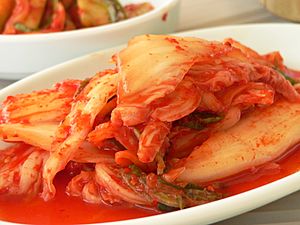List of Korean dishes facts for kids
Welcome to the exciting world of Korean cuisine! Get ready to discover a list of delicious dishes from Korea, known for their amazing flavors and unique ingredients. Korean food is often spicy, savory, and full of fresh vegetables, meats, and seafood.
Popular Korean Dishes
Royal Court Delights
These special dishes were once served to kings and queens in Korea. They are often very fancy and beautiful!
- Gujeolpan (구절판): Imagine a colorful plate with nine sections, each holding different cooked vegetables and meats. You wrap them in thin pancakes, making a perfect bite! It's usually served at big celebrations.
- Sinseollo (신선로): This is a rich stew with various meats and vegetables, cooked in a special silver pot. The pot has a hole in the middle where hot coals are placed to keep the food warm throughout your meal.
Grilled Goodness
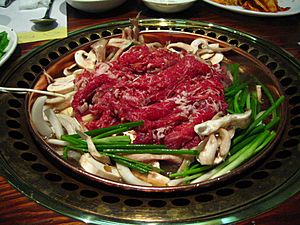
Korean barbecue is super popular, and for good reason! Many dishes are cooked right at your table on a grill.
- Bulgogi (불고기): This means "fire meat"! It's thinly sliced beef marinated in a sweet and savory sauce made with soy sauce, sesame oil, garlic, and sugar. You cook it on a grill, and it's incredibly tasty. You can also find dwaeji bulgogi (pork), dak bulgogi (chicken), or ojingeo bulgogi (squid).
- Galbi (갈비): These are juicy pork or beef ribs, often thicker than bulgogi. They are grilled over charcoal, sometimes right at your table. It's another favorite "Korean barbecue" dish.
- Samgyeopsal (삼겹살): This is unseasoned pork belly grilled until crispy. People often grill it with kimchi, garlic, and onions. Then, they dip it in a special sauce and wrap it in fresh lettuce leaves.
- Dak galbi (닭갈비): Chunks of marinated chicken are stir-fried with vegetables like cabbage and sweet potato, plus chewy tteok (rice cakes), all in a spicy red pepper sauce. It's a specialty from the city of Chuncheon.
- Makchang gui (막창구이): Grilled pork intestines, often served with a light soybean paste sauce. It's very popular in the Daegu area.
- Gobchang gui (곱창구이): Similar to makchang, but made with the small intestines of pork or ox.
- Saengseon gui (생선구이): Simply grilled fish.
- Seokhwa gui or jogae gui (석화구이 or 조개구이): Grilled shellfish, like oysters or clams.
Steamed and Braised Dishes
These dishes are cooked slowly with steam or in a flavorful liquid, making them super tender.
- Galbijjim (갈비찜): Tender beef short ribs braised (cooked slowly in liquid) with potatoes and carrots in a savory soy sauce.
- Andong jjimdak (찜닭): Steamed chicken with vegetables and clear cellophane noodles in a delicious soy sauce.
- Gyeran jjim (계란찜): A fluffy, steamed egg custard, sometimes with seafood. It's warm and comforting.
- Oiseon (오이선): A traditional dish made from steamed cucumber, often filled with beef and mushrooms.
Fresh and Raw Bites
Some Korean dishes are enjoyed fresh and raw, offering unique textures and flavors.
- Sannakji (산낙지): This is live octopus! It's served freshly prepared and can still move on the plate, offering a very unique experience.
- Yukhoe (육회): Similar to beef tartare, this dish features seasoned raw beef.
- Hoe (회): Raw seafood, often dipped in spicy gochujang (red pepper paste) or soy sauce with wasabi. You can wrap it in lettuce or perilla leaves.
Soups and Stews

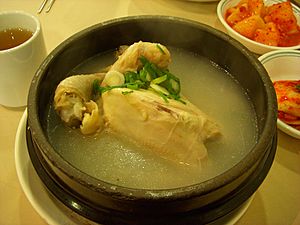
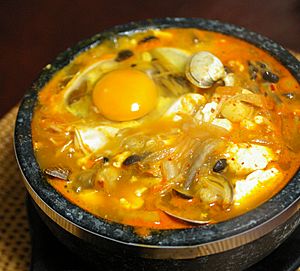
Korean meals often include a warm soup or a hearty stew.
- Guk (국): This is a general term for soup.
- Tteokguk (떡국): A comforting soup made with thin slices of chewy tteok (rice cake).
- Miyeok guk (미역국): A healthy seaweed soup, often eaten on birthdays.
- Manduguk (만두국): A delicious soup filled with Korean dumplings.
- Tang (탕): These are usually thicker, heartier stews.
- Samgyetang (삼계탕): A whole small chicken stuffed with ginseng, glutinous rice, jujubes, and garlic, then simmered into a healthy soup. It's traditionally eaten in summer to boost energy.
- Seolleongtang (설렁탕): A milky white beef bone broth, simmered overnight. It's served with thin slices of beef and cellophane noodles.
- Gamjatang (감자탕): A spicy pork spine stew with vegetables, especially potatoes, and hot peppers. It's a popular late-night snack or meal.
- Daktoritang (닭도리탕): A spicy chicken and potato stew.
- Jjigae (찌개): These are flavorful, often spicy, stews.
- Doenjang jjigae (된장찌개): A savory soybean paste stew, usually with vegetables, tofu, and sometimes seafood. It's a staple at Korean meals.
- Kimchi jjigae (김치찌개): A super popular spicy stew made with kimchi, pork, and tofu. It often comes to your table still bubbling in a hot stone pot!
- Sundubu jjigae (순두부찌개): A spicy stew with very soft tofu and shellfish. People often crack a raw egg into it while it's still boiling.
- Budae jjigae (부대찌개): This means "army base stew." After the Korean War, people used leftover foods from US Army bases, like hot dogs and canned ham, and added them to a traditional spicy soup. Today, it often includes instant ramen noodles and is still very popular.
Rice and Grain Dishes
Rice is a main part of almost every Korean meal.
- Bibimbap (비빔밥): This means "mixed rice"! It's a bowl of warm rice topped with colorful seasoned vegetables like spinach, mushrooms, and carrots, plus a dollop of spicy gochujang (red pepper paste). You mix everything together before eating.
- Dolsot Bibimbap (돌솥 비빔밥): A special version served in a hot stone bowl. The heat makes the rice at the bottom crispy, and a raw egg cooks as you mix it in.
- Boribap (보리밥): Rice cooked with barley.
- Nurungji (누룽지): The crispy, thin layer of rice left at the bottom of the pot after cooking. It's eaten as a snack or made into a porridge.
- Kimchi bokkeumbap (김치볶음밥): Delicious fried rice with chopped kimchi, vegetables, and often meat.
Banchan (Side Dishes)
Korean meals always come with many small side dishes called banchan. They add variety and flavor to your meal.
- Kimchi (김치): This is the most famous Korean side dish! It's usually cabbage or Korean radish fermented in a spicy brine with ginger, garlic, and chili pepper. There are countless varieties, and it's served with almost every meal. Kimchi is known for its health benefits!
- Ggakdugi (깍두기): Kimchi made with cubed Korean radish.
- Baek kimchi (백김치): White kimchi, made without chili pepper, so it's not spicy.
- Mulkimchi: "Water kimchi," which is a watery, refreshing kimchi.
- Namul (나물): This is a general term for seasoned vegetable side dishes.
- Kongnamul (콩나물): Seasoned soybean sprouts, often boiled.
- Shigeunchi (시금치): Lightly boiled spinach seasoned with salt and garlic.
- Ggaennip (깻잎): Perilla leaves marinated in soy sauce and sesame oil.
Noodles (Guksu)
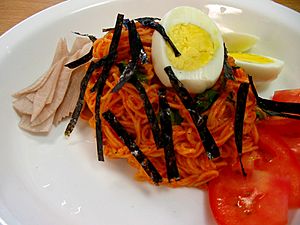
Noodles are a big part of Korean cuisine, served in many different ways.
- Naengmyeon (냉면): "Cold noodles"! These thin, chewy buckwheat noodles are served in a large bowl with a tangy, icy broth, fresh vegetables, fruit, and often a boiled egg and cold beef. It's super refreshing, especially in summer.
- Japchae (잡채): Clear cellophane noodles stir-fried with various colorful vegetables and small pieces of beef, all seasoned with soy sauce and sesame oil.
- Jajangmyeon (자장면): A very popular Chinese-inspired Korean noodle dish. It features thick noodles topped with a rich black bean sauce, usually with meat and vegetables like zucchini and potatoes. It's often ordered for delivery!
- Kalguksu (칼국수): Hand-cut flat noodles served in a warm broth, often made with anchovies and zucchini.
- Ramyeon (라면): The Korean version of instant noodles, usually spicy and very popular for a quick meal.
Snacks and Street Food
Korean street food is incredibly diverse and delicious!
Gimbap

Gimbap (김밥): This popular snack means "seaweed-rice." It's like a Korean sushi roll! Cooked rice, seasoned with sesame oil and salt, is spread on a sheet of dried laver (seaweed). Then, ingredients like fried egg, carrots, ham, seasoned beef, pickled Korean radish, and spinach are placed inside, and it's rolled up tightly. There are many kinds, like tuna, cheese, or bulgogi gimbap.
Korean Pancakes (Buchimgae)
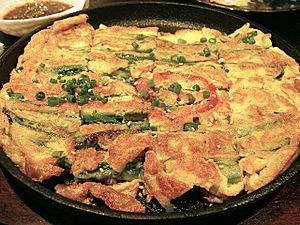
Buchimgae (부침개) are savory Korean pancakes. They are made by mixing various ingredients into a batter and pan-frying them until golden.
- Pajeon (파전): A savory pancake made with long spring onions and often seafood.
- Bindaetteok (빈대떡): A pancake made from ground mung beans, mixed with vegetables and meat, then pan-fried.
- Kimchibuchimgae (김치부침개): A spicy and savory pancake made with chopped kimchi mixed into the batter.
Other Fun Snacks
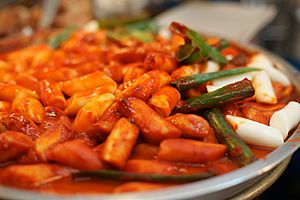
- Tteokbokki (떡볶이): A super popular spicy dish made with chewy sliced rice cakes and fish cakes, all coated in a vibrant red gochujang sauce. You'll find this everywhere as street food!
- Sundae (순대): A unique Korean sausage made with a mixture of sweet rice, pig's blood, noodles, and vegetables, stuffed into a natural casing.
- Hotteok (호떡): Similar to a pancake, but with a sweet, gooey filling inside! Common fillings include melted brown sugar, honey, chopped peanuts, and cinnamon. They are warm and delicious, especially in winter.
- Bungeoppang (붕어빵): These are fish-shaped pastries, usually filled with sweet red bean paste. They are crispy on the outside and chewy inside. You can often buy them from street vendors.
- Gyeranppang (계란빵): "Egg bread," a small, slightly sweet bread with a whole egg baked inside.
Desserts
Korean desserts are often less sweet than Western ones and focus on chewy textures and natural flavors.
- Tteok (떡): A chewy cake made from rice. It comes in many forms and can be filled with sweet pastes like mung bean or red bean, or topped with nuts and honey. It's a popular snack or dessert.
- Yakshik (약식): A sweet dessert made with glutinous rice, chestnuts, pine nuts, and jujubes, steamed until it turns a dark, rich color.
Refreshing Korean Drinks
- Makgeolli: A traditional Korean rice wine, often milky and slightly sweet.
- Insam-cha (인삼차): A healthy tea made from Korean ginseng root.
- Sujeonggwa (수정과): A sweet and spicy punch made from dried persimmon, ginger, and cinnamon. It's often served cold after a meal.
- Sikhye (식혜): A sweet rice beverage, often enjoyed as a dessert drink.
- Yuja-cha (유자차): A fragrant tea made from the Yuzu fruit, often served warm.
- Bori-cha (보리차): A popular roasted barley tea, often served cold in restaurants.
- Sungnyung (숭늉): A comforting drink made from the slightly scorched rice left at the bottom of the pot, mixed with water and boiled.
Images for kids


